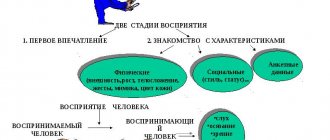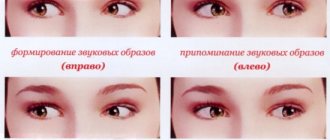Constancy of perception is the relative constancy of certain perceived properties of objects when the conditions of perception change. It is most clearly expressed in the visual perception of the size, shape and color of objects.
The constancy of the perception of the size of an object lies in the fact that the same object, being at different distances from the observer, is perceived by him as the same in size, although the size of the images of the object on the retina of the eyes decreases with its distance.
The degree of constancy of perception will be different at different distances. If you look at a pencil from a distance of 25 cm, and then from a distance of 50 cm, then its image on the retinas in the second case will be half as large as in the first. But its apparent size will not change: the pencil seems to us to be an object of the same size. This is a case of complete constancy. At a distance from 3 to 500 m, the visible size of objects gradually decreases, but to a lesser extent than the size of their images on the retinas. The constancy of the perception of magnitude becomes incomplete. At long distances it completely disappears. If the apparent size of objects at a distance of 1000 m is taken as one, then at a distance of 2000 m the object will appear half as large; at a distance of 10,000 m - 10 times less, etc. In other words, at long distances the visible size of objects will correspond to the projected size of their images on the retinas. The perception of magnitude becomes constant.
- The basis for the constancy of perception of the size of objects is a conditioned reflex to a complex stimulus: irritations from the eye muscles are added to irritations coming from the retinas. arising when they contract at the moment of fixation of the gaze on an object. This combination of stimuli, which coincides several times with tactile stimulation from an object of known size, is a signal of the actual size of the object (I. P. Pavlov).
At a small distance of objects from the observer, adaptive eye movements (convergence - bringing the visual axes inward and accommodation - changing the shape of the lens for better vision at different distances) increase, so the constancy of the perception of magnitude is complete or almost complete. When perceiving objects at large distances, the mechanism of convergence and accommodation is turned off. The main signal of the size of objects is the images on the retinas. The perception of magnitude becomes constant. When determining the size of an object at a distant distance, a person compares it with the size of other objects that are well known to him and located nearby.
It has been experimentally established that with binocular vision (when seeing with two eyes), the constancy of the perception of magnitude is higher than with monocular vision. And this is understandable: when observing with one eye, the number of motor impulses coming from the receptors to the cortex is significantly reduced due to the convergence being turned off; only the motor reflex of the lens remains. It has also been proven that the degree of constancy of the visible size of things well known to man is higher than in the perception of geometric figures, the size of which is usually arbitrary.
The perception of the shape of an object also has, within certain limits, the property of constancy.
The constancy of the perception of the shape of an object is the relative constancy of the visible form when the position of the object in space changes. The image of a flat object on the retina of the eyes changes depending on the position of the object in space. But the visible form of an object either does not differ at all from its actual form (complete constancy), or differs only slightly if we compare it with the shape of the image of the object on the retinas (incomplete constancy). Thus, the image of the plate will be either a circle or a more or less elongated ellipse, and the retinal edge of the notebook will be either a rectangle, or a rhombus, or a trapezoid, depending on the angle of view of the observer. But we usually perceive these objects as they really are; We see the plate as round, and the notebook as a rectangular quadrangle.
The constancy of the perception of the shape of an object is explained in the same way as the constancy of the perception of size. Looking at an object, we very quickly and imperceptibly trace its contours with our gaze. If an object is located at an angle to the line of sight, we notice that one of its edges is closer to us, and the other is further away. Irritations from the convergent and accommodative muscles combine with irritations from the retina of the eyes, forming a complex stimulus, with various variants of which (depending on the variants of the position of the body in space) a person is already familiar with previous experience.
Constancy of color perception is the relative invariance of the visible color of objects when lighting changes. We see black velvet and coal black both in midday sunlight and at dusk. And under the same lighting conditions we see sugar and chalk as white. This is a case of complete constancy of the visible color of objects. The constancy of the visible color of objects under chromatic lighting is less pronounced. We perceive snow as white both in the crimson sunset and in the blue light of neon lamps. However, under very bright chromatic lighting, the constancy of color perception may disappear, and objects will take on the color of the lighting. This feature of perception is widely used in the theater to create the desired impression on the audience.
The constancy of visible color is higher when an object is perceived against the background of other objects. Changing the intensity of illumination or its color simultaneously changes the color of all objects in the field of view. A person develops a conditioned reflex to the relationship between color stimuli, which allows him to recognize the colors of objects regardless of changes in lighting, i.e., constantly. For example, he saw many times a forest, a field, a sandy hill, a lake and the sky above them at sunny noon, at dawn, at foggy twilight, at night. Adapting to changing lighting, a person could not help but notice that the colors of all objects familiar to him change each time in a certain direction (some darken, others lighten, turn pink, turn blue, etc.). Thus, the sandy bank of a river in bright sunlight appears lighter than the water surface of the river, and at dusk, on the contrary, it appears darker.
The degree of constancy of color perception depends on the simultaneous or separate influence of several conditions: adaptation to the general level of brightness of the visual field, the effect of light contrast, and the perception of the light source. Additional conditions such as the distance of the object, shine, highlights, shadows, etc. also have an impact.
Content
- Physiological mechanism of perception
- Properties of perception
- Principles of perception
- Perception factors
- Effects of perception
- Classification of types of perception
- Perceptual disturbances Illusions of perception
- Hallucinations Eidetism as a type of hallucination
If we compare the definitions of two mental processes, i.e. perceptions and sensations, then you can notice some features. For example, perception is a more complex process. If sensations reflect individual properties of objects, then perception is a holistic reflection. Thus, the result of perception is a holistic perceptual image of an object, and not a separate property of it.
Perception as a perceptual activity.
Observation and observation
Perception can be considered not only as one of the cognitive processes, but also as a relatively independent perceptual activity. Perception as a process is included in various types of practical and mental activity of a person as one of its components, which are not always clearly recognized. But it becomes a relatively independent perceptual activity if it has a goal, a system of motives, methods of implementation and a certain result. Perceptual activity includes a number of perceptual actions.
Let us explain this with an example.
Someone, for example a geographer, goes to a river in order to study the characteristics of its flow in a certain place. He walks through the meadow, busy with his thoughts, poorly noticing the surrounding objects, but nevertheless not losing his way and avoiding the usual obstacles - a bush, a stone, a puddle. Perception, as part of his mental activity at the moment, acts as one of the processes of sensory reflection of the situation, without which activity would be impossible. But the path turned out to be a deep ravine that had to be crossed. Perception immediately becomes arbitrary and purposeful, transforms into a relatively independent activity that precedes practical actions: before crossing a ravine, one must carefully examine its slopes and bottom, that is, perform a certain system of orienting actions (perceptual actions). This activity, in turn, is subordinated to an activity that is broader in scope: having overcome the obstacle and reaching the river, the geographer chose a convenient place and began to observe the movement of water, the nature of the banks, etc., changing position several times and writing something in a notebook. Perception has become a special activity - observation. Perceptual activity can also include the perception of a film, landscape, concert, etc.
Currently, in the field of child and engineering psychology, numerous experiments are being conducted to study perceptual actions in their genesis (emergence and development) in a child and in the production activities of an adult, for example, in the work of a dispatcher or other operator. Researchers point out that perceptual actions occur in a certain sequence and form a certain system of actions, namely: first, the object is detected; then highlighting its most informative features, for example, the contour characteristic of a given object; This is followed by familiarization with the selected features (examination, feeling, etc.) and, finally, identification of the object, i.e., assigning it to a certain category of objects (for example, plants, animals, mechanisms, etc.). As indicated at the beginning of the chapter, in adults these indicative and exploratory actions proceed quickly, in a “collapsed” form. Detection and identification are extremely difficult when there is rapid oncoming movement of an object and an observer, for example a pilot, a machinist, or a driver. The duration of perceptual actions is measured in seconds or fractions of a second. With such a lack of time, it is difficult to avoid mistakes.
One of the teacher’s tasks is to teach children to observe and develop in them a vitally valuable personality trait - observation. Observation is a long-term, targeted perception of an object, carried out according to a specific plan, followed by analysis and generalization of the data obtained.
Observation is necessary in any human activity - educational, labor, creative. Before completing any task independently, the student watches how the teacher performs it. Before starting work on a new or repaired machine, a worker observes it, checking the serviceability of individual parts and the mechanism as a whole. A teacher, teaching and raising children, constantly monitors the behavior of students, the process of their assimilation of knowledge, the characteristics of each student’s work, and the results of his educational influences. In scientific activities, observation often acts as a special research method, for example in the natural sciences, psychology, etc.
Observation only gives valuable theoretical or practical results when the following conditions are met.
- The observer clearly understands the purpose of observation, has practical knowledge of observation techniques in this area and has some knowledge about the object of observation. Sometimes special instruments are required for observation; they must be studied in advance.
- There is an observation plan that specifies the sequence, time, location and number of observations.
- Observation data is recorded in the form of descriptions, protocols, transcripts, sketches, photographs, phonograms, film documents, collections of samples, etc. Objectivity requires that not only those facts that correspond to the observer’s hypothesis are selected and recorded, but also facts that contradict it.
- The observation results are carefully analyzed, compared, and, if possible, subjected to quantitative processing. All this is necessary to identify the essence and patterns of connections of the object being studied.
People who, from an early age, are accustomed to purposeful and systematic observations of the phenomena of the surrounding world, develop powers of observation. Observation is a persistent typical feature of a person’s mental make-up, which manifests itself in the ability to sufficiently fully and comprehensively perceive and imagine objects in the surrounding world, highlight subtle, but sometimes quite significant features in them, notice differences in similar phenomena and objectively interpret the results of one’s observations.
Some people have all-round powers of observation, while others are predominantly observant in a particular area, such as nature, technology, or human psychology. Observation is a very valuable human ability, necessary for the formation of his thinking and for practical activities. It needs to be developed in children as early as possible.
Physiological basis
What is the psychophysiology of perception? The processes that occur during a person’s cognition of the surrounding world (this is an almost continuous process) can be recorded at the level of sensory organs , nerve fibers and the central nervous system; they are called the physiological basis of perception.
The mechanism of their action can be clearly explained as follows:
- stimuli at the nerve endings of the sense organs transmit the received information to the cerebral cortex;
- then it enters the projection zones of the brain, which are called sensory;
- a feeling of the information received and its comprehension is created.
Any “malfunction” of this chain can disrupt the integrity of perception.
For example, loss of vision , as a property of a sensory organ, limits the resulting image in terms of its color, volume, shape, etc., and a failure at the sensory level will lead to the fact that a person will perceive what he sees only as a set of light and color spots.
The nerve connections through which the process of perception works come in 2 directions:
- formed after the influence of one analyzer - for example, the noise of water in a river, which we do not yet see, affects only our hearing aid;
- inter-analyzer - figuratively speaking, they arise when we approach the river, here a whole complex of sensations comes into force, including associative ones.
Modality
There are 4 sensory information perception systems (models - hence the name) that people use:
- the visual system involves the perception of color and shape, that is, what we see;
- the auditory system uses sounds, their volume, timbre, rhythm, frequency;
- the kinesthetic system perceives taste, smell, temperature;
- digital uses logical constructions.
Functions
During a person’s lifetime, perception performs several main functions :
- general orientation;
- assessment of the location of individual objects and phenomena;
- the cognitive function already includes the discovery of the essence of objects and phenomena, their interconnectedness;
- activity control;
- regulation of activities.
The main properties of perception include:
- objectivity - a person is aware of the object he sees as a separate body;
- integrity , - individual properties of objects necessarily (if we are talking about apperception) add up to a visual image;
- structure is not a mechanical sum of sensations, but their correlation over a period of time: when listening to music, we perceive not individual notes, but an evolving melody;
- constancy - thanks to this quality, a person perceives moving objects as constant in their form and properties;
- meaningfulness - at this stage the final formation of the image of an object and phenomenon and its place in the surrounding world occurs.
Types of people
There are several types of perception:
- visual : it occurs with the dominance of what is seen;
- auditory - it is mainly based on sounds;
- discrete is based on numbers and symbols;
- There is also a more complex perception, based on other senses.
These types cannot be evenly distributed in our consciousness; for some, some are better developed, for others, others are better developed.
Accordingly, people are divided into individuals with different dominant types of perception :
- the visual person notices something faster, the words predominate in his speech: I saw, I looked, I imagined;
- the auditory person often speaks about what he heard and relies primarily on sound sensations;
- kinesthetic is emotional, constantly talking about sensations;
- Digital is based on logical constructions.
Examples
Of course, there are no people who use only one form of perception, just as there are no purely expressed types; they are often mixed. However, examples of the perception of people with one dominant personality are not difficult to identify.
Visual people value beauty in the surrounding space, do not tolerate clutter, the chaotic arrangement of things, and do not like it when the room is dirty.
The visual person makes many plans, often unrealistic, because they do not always perceive reality realistically. However, people of this type can also be generators of great ideas.
Auditory learners love sounds and, accordingly, first of all, music; they often compose it well themselves.
They have a well-developed auditory memory. They can imitate the speech of another person, sounds made by animals and even machines.
Observations show that auditory learners make good speakers and teachers.
Kinesthetics are emotional, sensitive, and changeable in mood. In interpersonal communication, they subtly sense the state of their interlocutor. When exploring an unfamiliar area and room, great importance is attached to touching and feeling.
Even touching the hand of the interlocutor is an important element of communication for them.
Digital people try to identify some kind of connection and pattern in everything they see and hear. They are prone to lengthy and very careful analysis of perceived phenomena.
Psychologists note that it is people of this type who, in stressful situations, are better than those around them in maintaining self-control and finding a way out of the current situation.
Levels
In psychology, there are 4 main levels of perception:
- sensory - it is based on the senses, it is considered to be the lowest level of perception, at which all living organisms are located, however, it also depends on the level of consciousness, since a person, say, consciously, can perform certain sensory actions;
- perceptual - the object is classified at the initial stage;
- research - examination of a particular function, aspect of an object or phenomenon;
- activity - interaction with the object under study, as for the purpose of a certain activity.
Theories
There are several scientifically based theories of perception that have their own valid arguments:
- Associative , its prominent representative was G. Helmholtz - according to this theory, the image of objects and phenomena is formed on the basis of associative sensations.
- Gestalt theory - its adherents, on the contrary, believed that we perceive each object as a separate whole, without connection with past experience and associations.
- Gibson's theory - its adherents were confident that perception cannot be objective, it depends on the degree of human activity; movement, in their opinion, is the basis of perception.
- According to Hebb's theory , perception is not an innate trait and has no innate elements at all; a person learns to understand the world gradually, first learning the details, and then the whole.
- The theory of perception by J. Piaget , who closely linked perception with the development of intelligence, is based almost on this
Effects and phenomena
A separate chapter of perception in psychology is the perception of a person by a person. It has a number of effects and phenomena, which are clearly shown in the table.
| Effect name | Causes | What is expressed in |
| The effect of primacy and novelty | Meeting with a stranger | The first impressions received are taken as a basis |
| Halo effect | There is already certain information about the person | The impressions received are projected onto previously known ones through the aura of rumors, information, etc. |
| Attractiveness effect | A person's appearance | We perceive an outwardly attractive person better |
| Superiority effect | Comparison of behavior, appearance, etc. | Feeling our supposed superiority over our interlocutor in some respects, we may underestimate him; the process may also be reversed. |
| Good attitude effect | Sympathy for a person | Overestimation of the interlocutor |
| Projection effect | Increased self-esteem | A pleasant person is assigned his own merits, and an unpleasant person is assigned his own disadvantages. |










